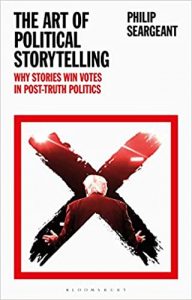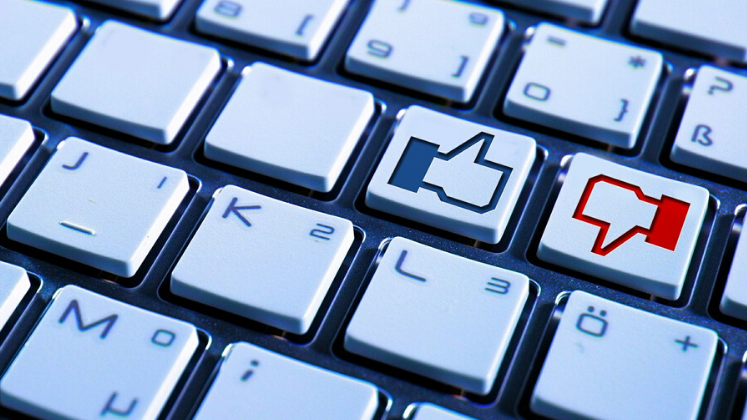In The Art of Political Storytelling: Why Stories Win Votes in Post-Truth Politics, Philip Seargeant makes the case that the basic archetypal structures of narrative are integral to political processes, including the ways that sense is constructed in public debate. Combining a sound and rigorous academic argument with a clear and accessible style, this book is a valuable dissection of current political realities and a manual for those engaging in or analysing politics in the contemporary post-truth era, recommends Ignas Kalpokas.
The Art of Political Storytelling: Why Stories Win Votes in Post-Truth Politics. Philip Seargeant. Bloomsbury. 2020.
Find this book (affiliate link): ![]()
 Among the things that are often taken for granted to describe today’s societies are the assumptions that life differs from fiction and that political actors, including voters, are rational utility-maximisers. Both views have their origin in Enlightenment thinking and have been strongly reinforced by nineteenth-century positivism and twentieth-century rational choice approaches. Nevertheless, the political processes of the twenty-first century have started to challenge the certainties of the past. In this context, Philip Seargeant’s The Art of Political Storytelling engages in an ambitious effort to demonstrate that we need to re-evaluate our assumptions about the choices we make and the ways in which sense is constructed in public debate. It turns out that the basic archetypal structures of narrative hold a much greater sway over our lives and decisions than we are often ready to admit.
Among the things that are often taken for granted to describe today’s societies are the assumptions that life differs from fiction and that political actors, including voters, are rational utility-maximisers. Both views have their origin in Enlightenment thinking and have been strongly reinforced by nineteenth-century positivism and twentieth-century rational choice approaches. Nevertheless, the political processes of the twenty-first century have started to challenge the certainties of the past. In this context, Philip Seargeant’s The Art of Political Storytelling engages in an ambitious effort to demonstrate that we need to re-evaluate our assumptions about the choices we make and the ways in which sense is constructed in public debate. It turns out that the basic archetypal structures of narrative hold a much greater sway over our lives and decisions than we are often ready to admit.
The central question driving this book is what drives people towards making seemingly irrational choices and falling for candidates who manifest a very relaxed attitude to truth and facts. In this sense, The Art of Political Storytelling clearly falls within the burgeoning literature on post-truth (as also indicated in the book’s subtitle). However, instead of subscribing to the dominant attitude that associates post-truth with some kind of moral decline or postmodern scepticism (as in the works of James Ball, Lee McIntyre or Matthew d’Ancona), this book is focused on the way in which post-truth politics intuitively makes sense by way of powerful narratives (see, for example, Ilan Zvi Baron or Ignas Kalpokas).
Nevertheless, Seargeant goes further by laying down an entire theory of post-truth story-making and rhetoric. He identifies the heroic archetypal structures underlying post-truth politics and, via the author Kurt Vonnegut, shows how basic storylines define the narrative structures of today’s politics in the same way they define novels or classic fairy tales. In this way, the book goes beyond merely suggesting that politics is structured as a story – in fact, it transpires, politics is, at its very heart, a story in itself. This kind of thinking has the clear benefit of offering a different understanding of post-truth politicians – instead of seeing them solely as pure and depraved manipulators (the default position found in works such as Nancy L. Rosenblum and Russell Muirhead), they become more like master storytellers: as though Homer himself was running for office.
The book immediately homes in on populism, which Seargeant identifies as the key mode of politics of our time, either as the modus operandi of its adherents or as something that its opponents rally against. No less importantly, though, the conditions for contemporary political performances are set by technological factors, particularly the need to ‘hack’ attention in an era of cognitive overload and digital over-saturation. In this environment, fakery – and the outrage of those still adhering to a traditional view of truth – might simply be a strategy for audience captivation. Ultimately, the result can only be defined as a destabilisation and fraying of the fabric of reality, contributing to an environment in which one can ultimately choose a version of the world that one likes and, therefore, select political actors who tell stories in accordance with such tastes. To a large extent, politics becomes similar to a film or music streaming service: one can choose to stream one’s favourites for either ambience or dedicated consumption, while at the same time being subjected to the algorithmic logics of attention that, on this occasion, structure the information environment.

Of course, one might well object that this particular theoretical framework is not particularly new and that most books on post-truth and other malaises of contemporary politics adopt some version of it. Nevertheless, one major thing that such a framework does not do on its own is provide an answer to the question of why people happen to fall for particular stories (or, at least, an answer that would go beyond the narrow technological determinism of ‘the algorithm did it’). Seargeant addresses this issue powerfully through his convincing exposition of rhetorical tools and archetypal structures. In this way, politics truly becomes an art form – again, in a way not dissimilar to music or film (or a novel, for that matter, which is the art form that Seargeant most often deals with) – in which the decisions of the author become no less important than the environment of reception.
Even though the book deals with rather similar subjects and characters to the wider post-truth literature (Donald Trump and the Brexiteers frequent its pages), the innovative perspective adopted by Seargeant allows readers to see such familiar subjects in a new light. Above all, the book is an extremely useful how-to tool to cut through the bravado and the brashness of post-truth politicians and understand the underlying mechanisms and motivations by exploring the rhetorical apparatus of contemporary politics, the technological facilitation of post-truth narratives and the use of emotions, such as hope and fear.
As a result, the key premise for understanding politics is the realisation that it is ‘a concoction of the effects of modern media technologies, anti-establishment opinion and emotional conviction’ (17), organised and channelled through political discourse. This approach is extremely effective in delineating the paths taken and strategies adopted by contemporary politicians. Despite being oriented towards peddling evocative, and yet often meaningless, kitsch (indeed, precisely because of kitsch’s lack of a fixed meaning), these strategies appear to be efficient in mobilising support and quite literally making sense. In this way, an efficient post-truth political narrative allows one to access a deeper layer of meaning – the truth beyond the lie. Hence, while the words of post-truth politicians may be devoid of signification in relation to verifiable facts, they are nevertheless meaningful in terms of conveying the experienced conditions, the feelings and the yearnings of the target audience, thus making them powerful and evocative.
In many ways, The Art of Political Storytelling is both a dissection of current political realities and a manual for those engaging in or analysing political processes in the contemporary post-truth era. Crucially, Seargeant manages to combine a sound and rigorous academic argument with a clear and accessible style. For this reason, the book is accessible to a wide set of audiences, from students and academics to the general population. It will also be an indispensable tool for media literacy educators and anybody working to raise awareness of the vicissitudes of contemporary political discourse. Overall, then, everybody with at least a fleeting interest in politics must read this book.
Note: This review gives the views of the author, and not the position of the LSE Review of Books blog, or of the London School of Economics. The LSE RB blog may receive a small commission if you choose to make a purchase through the above Amazon affiliate link. This is entirely independent of the coverage of the book on LSE Review of Books.
Image Credit: Photo by Kane Reinholdtsen on Unsplash.







